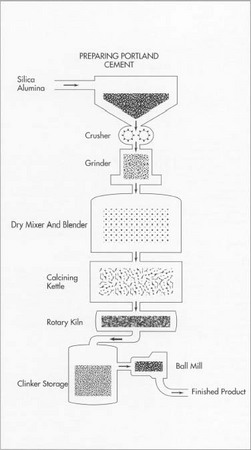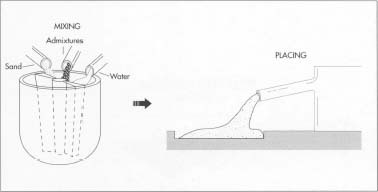| Bibliographic Entry | Result (w/surrounding text) | Standardized Result |
|---|---|---|
| Dorf, Richard. Engineering Handbook. New York: CRC Press, 1996. | "The density of normal concrete is 2400 kg/m3 and the density of lightweight concrete is 1750 kg/m3 | 1750–2400 kg/m3 |
| Brooklyn Public Library Files; 1999 | "Typical density of concrete (2.3 g/cm3)" | 2300 kg/m3 |
| McGraw-Hill Encyclopedia of Science and Technology. | "Volume generally assumed for the density of hardened concrete is 150 lb./ft3. (2400 kg/m3)" | 2400 kg/m3 |
Concrete is an artificial material similar to stone that is used for many different structural purposes. It is made by mixing several different coarse aggregates such as sand and pebbles with water and cement and then allowing it to harden by hydration. Hydration causes crystals to form that interlock and bind together. According to the Brooklyn Public Library, concrete was first made in 500 BC and can last up to 50,000 years. Concrete is one of the most important building materials. From sidewalks to skyscrapers, we see concrete everyday everywhere. There are many different kinds of concrete. Reinforced concrete is strengthened by steel. This is done by casting concrete around steel rods or bars and most large structures such as bridges need this extra strong concrete. Prestressed concrete is made by casting concrete around steel cables stretched by hydraulic jacks. After the concrete hardens the jacks are released and the cables compress the concrete. Concrete when compressed is the strongest. This type of concrete is used for floors and roofs as well as other things. Precast concrete is cast and hardened before being used for construction. Precasting makes it possible to produce a mass number of concrete building materials. Nearly all of pre stressed concrete is precast as are concrete blocks. Concrete blocks are made in various weights and sizes and they are used to make about two-thirds of masonry walls in the US. Engineers have designed kinds of concrete for certain uses. Air-entrained concrete is good in harsh weather and is used for roads and airport runways. High-early-strength Concrete is used in hurried jobs and cold weather because it hardens quicker than ordinary concrete. Lightweight concrete weighs less than any other concrete because it is made from pumice: a naturally light mineral.
| Bibliographic Entry | Result (w/surrounding text) | Standardized Result | |||||||||
|---|---|---|---|---|---|---|---|---|---|---|---|
| Concrete Basics. Portland Cement Association. | "Density in Place: Density of normal CLSM in place typically ranges from 90 to 125 pounds per cubic foot (1840 to 2320 kg/cubic m)." | 2320 kg/m3 (conventional) | |||||||||
| Conversion Factors, Material Properties and Constants, Edward Boyden, MIT. | "Density Concrete 2242 kg/m^3" | 2242 kg/m3 (conventional) | |||||||||
| Material Notes. Faculty of the Built Environment, University of New South Wales. | "While conventional concrete has a density of about 2300 kg/m3, lightweight concrete has a density between 160 and 1920 kg/m3." | 2300 kg/m3 (conventional) 160–1920 kg/m3 (lightweight) | |||||||||
| Cube Competition. Concrete Society of Southern Africa. | "The concrete must be of a lightweight nature, with a mass of not greater than 1.5 kg/100 mm cube or a density of 1500 kg/m3" | < 1500 kg/m3 (lightweight) | |||||||||
| Baldwin, Kelly. "Electrically Conductive Concrete: Properties and Potential."Construction Canada. Vol. 98, No. 1 (January/February 1998): 28-29. | "Density (kg/m3) 1450–1850" | 1450–1850 kg/m3 (conducting) | |||||||||
| Concrete Admixture 453. Pt. Union Ajidharma. |
| 2320 kg/m3 (conventional) | |||||||||
| Transit Mix Perlite Concrete. Schundler Company. |
| 648–808 kg/m3 (lightweight) | |||||||||
| Aerated Concrete, Lightweight Concrete, Cellular Concrete and Foamed Concrete. Pan Pacific Management Resources. |
| 300–1600 kg/m3 (lightweight) | |||||||||
| Is anyone buried in Hoover Dam? Bureau of Reclamation, US Department of the Interior. | "Typically, concrete has a density of 150 pounds per cubic foot, which means that a block of concrete that is one foot wide, one foot long, and one foot high would weigh 150 pounds. Water has the density of only 62.4 pounds per cubic foot." | 2400 kg/m3 | |||||||||
| Pavement Conversion Factors. Washington State Department of Transportation. |
| 2403–2439 kg/m3 |





























